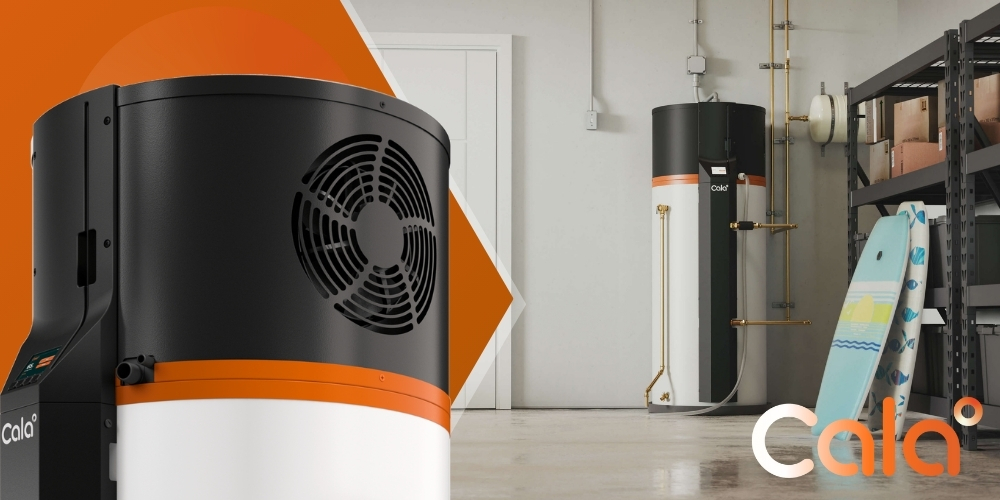How Poor Duct Design Affects Heating and Cooling Performance

Intelligent Heat Pump Water Heaters for Massachusetts Residential Homes — Why SumZero Selects Cala
By SumZero Energy Systems — Massachusetts’ #1 Heat Pump Installation Team
Picking a new water heater once involved a simple decision between gas and standard old electric, praying the hot water wouldn't be gone when there were two showers in a row. That's no longer the case. Now, the ideal solution for the majority of Massachusetts homes is a smart heat pump water heater (HPWH). This isn't the typical hybrid of which you might have heard, but a rather new breed of unit that adapts to your home's schedule, accommodates your energy usage, and maintains comfort consistently while consuming a lot less energy.
When homeowners want to have it exactly right the first time, our team is discerning about what products we choose. We consider the landscape and inspect the details before determining that they might work with Cala, a company that produces a high-technology hot water heater that modern homes need: intelligent, consistent, and efficient hot water — installed properly. This article describes why this alliance matters, how the tech benefits your home, what you should expect from our installation, and the handy information (rebates, credits, fit questions) homeowners inquire about daily.
Why This Alliance Is Important
(and What It Does for You)
There are two parts to a successful hot water solution:
Great technology
A system that makes you comfortable and uses less energy.
Great installation
Design, placement, airflow, electrical, condensate handling, commissioning, and long-term support.
Cala provides a tailor-built, smart HPWH platform. SumZero provides actual-world experience so that it works perfectly in real Massachusetts homes.
Together, we provide three things homeowners report wanting:
Accurate hot water at peak periods without guessing.
Cheaper monthly energy bills without compromise on comfort.
It is a future-proof solution that addresses the trend towards greener, all-electric homes.
Simply put: We get hot water. We know how to properly install heat pump technology. This combination makes a water heater upgrade a smart, long-term decision.
The Homeowner's Dilemma That We Are
If you have had a gas or a typical electric water heater, then you know the problems:
Hot-cold swings on hectic morning routines.
Higher electricity bills than hoped for.
No real insight, no real control.
A replace cycle that is experienced as "buying the same thing again."
Typical hybrid: Heat pump water heaters perform better, yet they still react: They delay until the tank cools off, then warm it up again. Homeowners averred they desire a system which thinks ahead—a unit which is a breeze to operate, handles peak load graciously, and does not make them compromise.
They fill that gap, which is why we work with them.

Why a Smart HPWH is Different
A standard electric water heater makes heat by passing an electric element, a giant toaster coil, through the tank. A heat pump water heater does it another way: it takes heat from the air it lives in and puts it into the water. Because it costs less energy to move heat than create it, heat pump water heaters run on much less power than typical electric ones. And they avoid burning gas, venting, and pollution.
A smart HPWH goes one step further:
It adapts to your home's schedule (morning showers, nighttime laundry) and preheats when demand isn't yet high.
You can use the app to check, plan, or increase hot water whenever you want.
It has a compressor that can change speed to fit what you need (not just "on/off").
It is achievable with a mixing valve holding water at the proper warmth for improved efficiency and then providing a sustained, safe warmth for usage. This is also possible with the availability of additional warm water at peak usage times.
It goes nicely with a contemporary home — primed for solar, time-of-use, and information you can view at a glance.
Result: more stable comfort, less energy use, improved control.
Why a Smart HPWH is Different
From what is visible on-site, there are three things certain for homeowners regarding the points of Cala:
1) Ease That Is Effortless
Consistent hot water at peak use is the ultimate test. Through forecasting demand and using a mixing valve, Cala maintains a steady supply. That results in less "uh oh" when two showers coincidentally happen at once or someone turns on the dishwasher.
2) Controls That You'll Ever Use
App functionality is key when done properly. You can check if there's hot water, turn up the heat for guests, view energy usage history, or simply set it and leave. As installers, we appreciate performance data — it allows us to address little issues before large ones form.
3) Future-Ready from Day One
Massachusetts is going towards clean, electricity-based homes. Cala's strategy combines well: it is scalable for solar power and accounts for time-of-use rates when needed. If you foresee solar energy at some time, or already have it, this water heater won't stop your home from being efficient.
4) A Company That Stands Behind Its Product
Cala backs every unit with a 10-year parts warranty and 3-year labor warranty — a strong sign they stand behind both the technology and the people who install it. At SumZero, we respect that kind of commitment because it mirrors our own approach: taking care of homeowners and supporting our partners with the same level of trust and accountability.
What SumZero Offers As Your Installer
(Why It Matters)
Even the best system won't work so great if installed wrong. Our task is getting your new HPWH working perfectly inside your home, not on a drawing board. This is what our approach is:
Right-size design.
We measure how much water your home needs and discuss the high-flow fixtures, filling bathtubs, and washer usage.
Best installation and ventilation.
HPWHs require air to make the heat move. We consider the room size, doors, vents, and — when necessary — ducting solutions for high performance and low noise.
Clean handling of electricity and condensate.
Safe power, tidy routing, and a trustworthy drainage plan are essential.
Commissioning correctly.
We don't just "turn it on." We verify performance, position the mixing valve, help you with the app, and verify your comfort objectives.
Rebates, credits, and financial assistance.
Mass Save, federal 25C, and the 0% HEAT Loan (if applicable) — we'll help you with that.
We take special care.
Our teams respect your home, protect your floors, and leave the place nicer than they found it.
Aftercare you can count on. Questions years down the road? We're here. The whole concept of a smart system is long-term confidence, not a one-day installation.
Costs, Incentives, and Lifetime Value
Two parts matter here: upfront cost and operating cost.
→ It is a better unit than a standard electric or simple hybrid. Tax credits and rebates make a big difference. A lot of Massachusetts homeowners rely on the 0% HEAT Loan for easier payments.
→ Month after month, the intelligent HPWH's effectiveness is where the value lies. By transferring (not creating) heat and by scheduling heating intelligently, homeowners consistently experience significant decreases in water-heating energy consumption — particularly relative to resistance electric, and many times relative to gas or delivered fuels when full costs are factors.
If you'd like figures specific to your home (household number, showering usage, energy costs), we'll do the math at your consult and provide you with a clear estimate of payback, lifetime cost saving, and the rebates for which you qualify.
Are Smarter Heat Pump Water Heaters Good for Your Home?
It is feasible for many Massachusetts homes. We will cover:
→ Household size and routines. Families with up to about 5 people usually do well with the standard setup; we will give advice for larger families or special situations.
→ Space and ventilation. We check the space, door vents, or ducts if necessary, and ventilation so the system operates properly.
→ Location. Basements are typical, as are utility rooms. As the unit functions, it removes air that feels like a dehumidifier — a typical plus for basements.
→ Electrical. We check panel capacity and proper wiring; no installation day surprises.
→ Future plans. Now or in the future for solar? Time-of-use rates? We'll put the system on so it grows with your home.
[[cta-heatpump]]
Why Is Cala Different from "Traditional Hybrids"?
✪ Control and Convenience:
Cala integrates intelligent tech with a mixing valve to remain comfortable, even when it is busy. Most standard hybrid units have simple modes and react only when the tank becomes chilled.
✪ Care and Trust:
Performance insights help you recognize problems early on and keep you on your feet for surprises. Traditional deployments are mostly "wait and see."
✪ Timing and Efficiency:
Variable driving and improved scheduling assist in energy saving with the maintenance of comfort. Ordinary hybrids operate more often and at undesirable times.
✪ Future-Ready
The design of the Cala accommodates with solar power, intelligent homes, and plans for utilizing electricity. Most older hybrids were not built for that usage.

What to Expect with SumZero
(From the First Call Through the First Shower)
✪ Talk & Pictures
We'll first glance at your objectives and take some fast photos of the current installation: the water heating unit, panel, and surrounding room.
✪ Right-Fit Design
We fit your hot water consumption and available spaces to a design which we endorse.
✪ Chaplain: A Comprehensive
Your quote is going to be transparent, includes information for installation, accessories, and a checklist for incentives. The paperwork assistance takes care of our end.
✪ Professional Installation
Licensed, insured, and detail-orientated. We dispose of the old unit, prepare the site, install and commission a new system, and leave the site tidy.
✪ App Introduction and Instructions
You'll discover how to see hot water supply, schedule increases, and view consumption — without being "technical."
✪ Support and Help
We're your long-term partner. Got a question? You call us — that's what homeowners deserve from the #1 heat pump installation company.
Common Questions We Get
(And Easy Answers)
Smart heat pump water heaters move heat from the surrounding air into the water instead of generating heat directly. This makes them up to three to four times more efficient than standard electric models. Cala’s intelligent system takes it further — it learns your household’s patterns, preheats before busy periods, and gives you app-based control to monitor or boost hot water anytime.
Most hybrid water heaters react when the tank cools. Cala predicts when your home will need hot water and heats proactively, saving more energy while maintaining comfort. It also features a variable-speed compressor, integrated mixing valve, and performance monitoring portal, giving both homeowners and installers a smarter, more reliable experience.
Savings depend on your energy source and usage, but many Massachusetts homeowners cut their water-heating costs by 50–70% when switching to a heat pump system. Cala’s intelligent controls add even greater efficiency. Add Mass Save® rebates, federal 25C tax credits, and potential 0% HEAT Loan financing, and most families see real payback within just a few years.
Yes — most Massachusetts homes are a great fit. Cala’s 65-gallon design comfortably serves households up to five people and can prepare up to 90 gallons ahead of peak use. The system needs adequate space and airflow, similar to a dehumidifier, and our team at SumZero handles every detail — from placement and ducting to electrical and performance checks.
SumZero Energy Systems is Massachusetts’ #1 heat pump installation team, trusted for precision, transparency, and high-quality service. We manage every step — design, installation, rebate paperwork, app setup, and long-term maintenance — so homeowners enjoy smarter comfort and lasting confidence. With SumZero, you’re not just buying equipment; you’re gaining a partner who stands behind it.
Why We Feel Secure Recommending This to Massachusetts Homeowners
We have a simple promise: we only install solutions that we would use in our own homes. Cala’s approach — being smart, having control, and being ready for the future — matches what we have learned from many talks with homeowners in the state. Together with SumZero’s careful installation standards and ongoing support, this water-heating upgrade makes sense right away and will last well with your home. Cleaner heat. Smarter comfort. Fewer bills.
Ready to Take the Next Step?

To learn more about Cala’s technology and vision, visit Cala Systems.
Why Duct System Redesign Matters More Than You Think
Massachusetts homes—especially the older ones scattered throughout historic towns—often hide a silent culprit behind inconsistent room temperatures and increasing energy bills: poorly designed ductwork. The unseen network of ducts that moves air from your heating and cooling system plays a critical role in household comfort and efficiency. When these systems are outdated or improperly configured, they can compromise everything from temperature control to indoor air quality.
According to the U.S. Department of Energy, nearly 30% of the air moving through ducts can be lost due to leaks and poor connections—wasting energy and money.
Homeowners often invest in advanced HVAC systems but see little improvement in comfort. Why? Because the real issue lies in how the air moves—or doesn’t move—through the duct system itself. Let's explore how a professionally planned duct system redesign can solve these problems and transform your living space.
Key Signs Your Home Needs Ductwork Installation and Replacement
Not every home needs a full HVAC overhaul. Sometimes, improving comfort is as simple as identifying the red flags pointing to poor duct design. Knowing what to look for helps Massachusetts homeowners take action before more costly issues arise.
Uneven Temperatures Room to Room
If some parts of your home feel like a sauna while others stay freezing, air isn’t being distributed efficiently.
- Bedrooms far from the air handler are often the coldest or warmest
- Sun-facing rooms feel stuffy, even with the AC on
- Air seems to barely flow from some vents
These inconsistencies typically stem from a mix of undersized ducts, poor layout, and airflow restrictions. HVAC airflow optimization starts by identifying where airflow breaks down.
Noisy Ducts or Whistling Sounds
Odd noises aren’t just annoying; they hint at design flaws.
- Rattling often means ducts are too small or joints are loose
- Whistling points to high pressure forced through tight spaces
- Banging or popping may result from temperature fluctuations in thin or uninsulated ducts
Sound is your home’s way of telling you that your ductwork needs attention.
High Energy Bills Despite a New HVAC
Even the most efficient system can't perform well with a poorly designed delivery system. When efficient airflow isn’t possible, your HVAC works harder, using more energy than necessary. This inefficiency often leads to:
- Short cycling or excessively long run times
- Overworked compressors and furnaces
- Increased wear and tear on major HVAC components
Many Massachusetts homes were built decades ago when energy efficiency wasn’t a priority, making them especially vulnerable to outdated duct configurations.
Better Comfort Through Custom Ductwork Solutions
Redesigning your duct system doesn’t mean starting from scratch. In many cases, custom ductwork solutions can integrate seamlessly with your existing HVAC equipment while vastly improving performance. The key is tailoring airflow to your home’s unique layout and ventilation needs.
Optimizing Airflow With Smart Layouts
An effective duct system starts with thoughtful design, not just straight lines.
- Rerouting ducts to minimize sharp turns and long runs
- Creating dedicated supply and return pathways in each room
- Balancing ducts based on room size and usage
Redesign improves how air moves, reducing pressure buildup that leads to noise and uneven temperatures.
Choosing Materials That Last
Modern ductwork isn't just about metal or fiberglass anymore. Today’s solutions offer more insulation and better air-tightness.
- Insulated flexible ducts reduce energy loss in unconditioned spaces
- Rigid metal ducts improve durability and reduce risk of collapse
- Proper sealing at every joint minimizes air leaks
These upgrades make your system quieter, more sustainable, and better suited for Massachusetts’ four-season climate.
Boosting Indoor Air Quality
Old, dusty ducts are often a source of allergens and household dust. New duct designs consider both air delivery and cleanliness.
- Proper airflow prevents moisture buildup, which can lead to mold
- Better return designs pull in air more effectively, preventing stale zones
- Upgraded filters catch more particulates without overworking the system
Duct redesign isn’t just a comfort upgrade; it’s a wellness investment for your entire family.
[[cta-heatpump]]
Finding the Right Ventilation and Duct Modifications for Your Home
Every Massachusetts home is different—farmhouses in the Berkshires, colonials in Lexington, Cape-style homes on the South Shore. What ties them together is the need for smart, functional ductwork that matches local weather and construction quirks. That’s where strategic ventilation and duct modifications make all the difference.
Prioritizing Energy Efficiency
Proper ductwork should support, not hinder, your HVAC system’s efficiency.
- Tightly sealed ducts prevent energy loss
- Zoning systems direct air only where you need it
- Smaller, efficient fans replace inefficient systems in older designs
Connecting these updates to state-sponsored efficiency programs, like Mass Save®, can even lead to rebates.
Adapting to Historic and Older Homes
Many beloved Massachusetts homes were built long before central air existed. Retrofitting ducts into these homes requires creativity and care.
- Space-saving duct solutions preserve architectural details
- Vertical duct runs and strategically placed vents avoid extensive remodeling
- Mini-duct systems make multi-room cooling possible without major construction
Incorporating air duct modification into these homes helps balance their charm with modern convenience.
Planning for Year-Round Use
Our cold winters and humid summers mean ductwork has to perform in every season.
- Winter airflow should keep every room comfortable—not just the ones closest to the furnace
- In summer, ducts must handle cooling loads while managing humidity
- Vent layouts should consider sun exposure, insulation, and even furniture placement
Did you know that poorly sized ducts can reduce your HVAC system’s efficiency by up to 40% in extreme weather?
The goal of every ductwork modification service is to match your system’s capabilities to your actual living habits—ensuring maximum comfort with the lowest energy use possible.
Conclusion: Duct System Redesign Transforms More Than Airflow
When it comes to home comfort, Massachusetts homeowners are often surprised to learn that their biggest upgrade isn’t a new system—but the supportive network behind it. Poor duct design can sabotage even the priciest HVAC investment. On the other hand, a thoughtful duct system redesign can unlock performance you didn’t even realize was missing.
With the right layout, materials, and airflow strategy, your home becomes more balanced, efficient, and enjoyable to live in—all year long.
So if your energy bills keep rising, certain rooms never feel right, or your HVAC is louder than it should be, it may be time to look behind the walls. That’s where real comfort begins.
Upgrade your home's comfort and efficiency with custom ductwork tailored to your space—discover how smart duct system redesign solves uneven temps and high energy bills for good.
Optimize My DuctworkYou Might Also Like…
Continue learning with handpicked articles that inform and inspire.
Not Sure Where to Start? We’ll Guide You
Let our experts design the right heating and cooling solution—customized for your comfort, your layout, and your energy goals. No pressure. Just clarity.
Request FREE ESTIMATE









